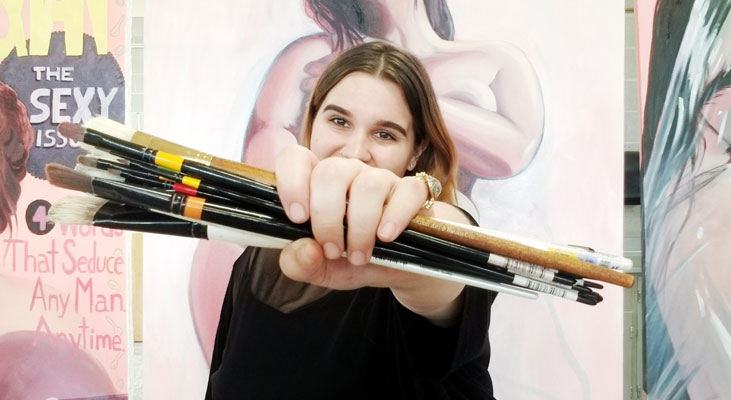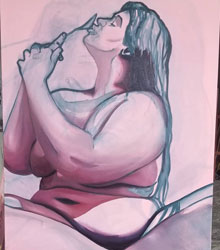Payge Rumler, ’20, Takes Another Look at Body Image Through FURSCA Project
September 16, 2019
By Jake Weber

Payge Rumler is a senior majoring in art with a concentration in the Carl A. Gerstacker Institute for Business and Management. She is the child of Carrie Rumler of Albion and Tim Rumler of Albion and a graduate of Concord High School. Find more of Rumler’s work and follow her progress on Instagram @madebypayge.
Like many young artists, Payge Rumler, ’20, started with an idea of creating artwork inspired by personal experiences, but she wanted to present her work in a way that felt relatable to women of all lifestyles and backgrounds.
“I wanted to talk about women and the attention on their bodies. As a fan of comedy, I started with a satirical take—in one of my first pieces, I used my body as the figure and I held balloons in front of myself to represent breast augmentation,” she explains. “This connected on a personal level of having always felt sexualized and yet never sexy enough, but it also worked on a statistical level. Through my reading I learned that breast-augmentation surgery has increased over 500 percent since the 1980s.”
The satirical works got great feedback—but her adviser, professor of art Michael Dixon, knew Rumler could do more. “He wanted to push me out of my comfort zone and told me to become more personal with my work,” Rumler explains. “I know there’s a link between plastic surgery and body image, but I’ve never actually had breast augmentation myself. Dixon told me to explore my own history before I start talking about what’s wrong with society.”
Dixon’s advice, combined with Rumler’s marketing and art history research—and a whole lot of paint and personal reflection—led to “Normative Discontent of the Modern Woman,” a series of paintings that does indeed address big issues through deeply vulnerable self-portraiture. Rumler researched artwork and imagery of “ideal” female figures throughout recent centuries, read books about body image, and even visited the Detroit Institute of Arts for inspiration.
“When I shifted my ideas, it was more difficult to come up with a composition I felt satisfied with,” says Rumler. “But I found that I was far more satisfied with the results when I worked from an idea that was more deeply personal. It felt cathartic.”

Rumler self-portrait
In making her work more personal, Rumler turned from satire to symbolism. “For instance, I use a spoon to represent the relationship I’ve had with my body. When I hold the spoon lovingly, it could be interpreted as a more positive relationship with food and with my body,” she explains. “But the spoon is simultaneously the literal thing that helped enable my eating disorder and the thing that, no matter how hard I tried, seemed impossible to abandon. This spoon represents this ongoing and conflicting relationship with my body.”
During her research, Rumler also uncovered an alarming relationship between this “ideal body” messaging and the Internet age.
“Fifty years ago, you had to go outside your home to get those messages,” she explains. “Now on your phone, you get those messages from your friends and from Instagram and from website ads. It’s that much harder to get away from the pressure to look beautiful.”
An art major with a business minor who sells her own original art and printed products, Rumler says Albion’s Foundation for Undergraduate Research, Scholarship, and Creative Activity (FURSCA) sponsored the creation of “Normative Discord” and gave her insights on her future career.
“Doing FURSCA made me see that I like the process—committing to at least eight hours of work each day, creating the references, making the canvases, mixing the paint, laying out the drawing, doing research,” she says. “You need to research art and art history whenever you can. It’s good to be original but without knowledge of the past it’s hard to build a foundation for your work. It can become fuzzy and confused if you don’t study what has worked for the artists before us.”
Rumler also wanted to let people know that making art isn’t always about relaxing and painting happy little trees. “Some people think that art students participating in FURSCA have it easier because we’re not doing math or science,” she says. “But with art, there’s no real answer to the question and you have to figure it out for yourself if you achieved what you said you would do. Even when you’re finished, you’re not sure. You must have a lot of confidence. There’s a lot more skill and responsibility than people realize.”
Finally, Rumler was pleased with the response she received from her FURSCA work.
“I’ve had women approach me and tell me that seeing my work is the first time they’ve felt their body and their struggles represented in a painting. The feeling I get after hearing something like that makes any challenge during this whole process absolutely worth it.”